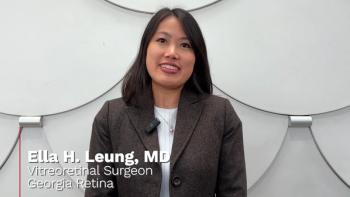
Small practices can succeed with a patient-first focus
Improving workflow can improve employee efficiency, boost revenue
Every step patients take, from the time they walk into your office until they are checked out, should be seamless to ensure your office is creating a positive atmosphere.
Reviewed by David I. Silbert, MD, and Heather Modjesky
For ophthalmologists in a small practice, improving patient flow may be vital to improving the efficiency and boosting revenue. There are a number of steps to make this happen.
Every step a patient takes-from the time they walk into your office until they are checked out-must move seamlessly to ensure you get the most out of your time and your patients come away with a positive experience.
She made a presentation titled “Efficiency First: Patient Flow and a Small Practice” during the 2018 meeting of the American Academy of Ophthalmic Executives. Modjesky was joined by
The practice has 1.5 full-time equivalent physicians, and four full-time and five part-time staff members with varying levels of experience. It also has fully integrated electronic medical records and electronic health records.
“We designed the office with an open concept that was done on purpose,” Dr. Silbert said. “We are an EMR and we use a small EMR called Medent. The company has a relationship with us, and they are willing to listen and help with change.”
Value of cross-training
By using the EMR and developing a cohesive staff that is cross-trained, Dr. Silbert and Modjesky have been able to improve the customer experience. They foster a new culture that stresses continued improvement for the staff. It has resulted in happier staff, shorter wait times, and positive feedback from patients. Modjesky utilizes data to help set goals for patient care.
She checks the
RELATED:
While staff support is great, he said
“When we are scheduling a new patient, we let them know the details,” he said. “If a child’s eyes have to be dilated, that is going to take time.”
Making patients part of the process fosters efficiency. Patients can offer feedback to be involved. In most instances, they simply want to be heard. When he is called away for an emergency, his staff is empowered to be proactive. They handle patients who may be waiting, and they will call patients to update them.
“Sometimes, you give them the option to reschedule,” she said. “They are always happy when you let them know.”
There are some patient-centered efficiencies that can improve flow.
They include:
- Don’t schedule patients without their insurance cards
- Clearly communicate with new patients to set expectations
- Direct all patients to complete new patient paperwork on an online portal
- Establish practice “know-it-alls” to finish informing patients about specific conditions or treatments.
- Call ahead and inform patients if they will be waiting longer than an hour for the physician. You can offer a later slot or reschedule.
A happy staff also is a well-paid staff, and that is another key to ensuring your small practice operates smoothly, according to Dr. Silbert.
“We pay employees well and expect a high level of performance for their salary,” he said.
As a small practice, stability and input from staff is key. He also sets the staff’s direction and works to keep them engaged. Taking risks is encouraged, even if it doesn’t work. Staff meetings that include the physician also benefit a small practice.
RELATED:
“We run lean all of the time,” he said. “By staying lean, we can have a bonus formula. We do bonuses across the board. We don’t use them as a retaliatory weapon.”
EHR gains
An EHR can help ensure a small practice is operating efficiently. With the EHR, management can observe every staff member’s use of the system, insert short cuts, create planned packages, and look for ways to standardize the process.
For example, surgery notes can be put in the EHR and sent to the surgery center, where the physician can easily access them in the file. Surgical documents also can be created in the EHR.
The increased efficiency gained from the EHR and ERM is driven by each member of the staff. Strong communication and an all-hands-on-deck team attitude are critical.
He cautioned against resisting an EHR, noting change may be needed and it can lead to efficiency gains and make you more efficient as a physician.
“The best compliment for me is when someone says, ‘I have never had as complete an examination as I had with you,’” he concluded.
RELATED:
Disclosures:
Heather Modjesky
E: [email protected]
Modjesky has no financial interests or relationships to disclose.
David I. Silbert, MD
E: [email protected]
This article was adapted from Dr. Silbert’s presentation at the 2018 meeting of the American Academy of Ophthalmic Executives. He is a consultant with Gobiquity, Quest and Kaneka. He has an equity interest in Gobiquity
Newsletter
Don’t miss out—get Ophthalmology Times updates on the latest clinical advancements and expert interviews, straight to your inbox.













































